► VW’s new ID.7 vs BMW and Mercedes
► The electric executive car market just got interesting
► How does the cheaper VW manage against the establishment?
Who remembers the Renault Safrane? It was a big brother to the Laguna, and was one of those cars that will come along every so often and try to ruffle the feathers of the premium peacocks that perpetually dominate the posh end of the saloon market. They try and they fail. The Safrane came and went in the ’90s; the BMW 5-series and Mercedes E-Class stayed, and spawned the i5 and EQE.
The saloon class is newly resurgent in the electric age, and there are plenty of manufacturers trying to stop the BMW/Mercedes dominance of the combustion-engined saloon market repeating itself. Today’s challenger is not a Renault (and strictly speaking not a saloon, either; it’s a saloon-ish five-door) but a VW, the ID.7.

The move back to lower, sleeker shapes makes a great deal of sense for EVs. With consumers looking for the best possible range, a car is generally going to provide better aerodynamics and less weight than an SUV with a similar footprint. That means you’ll go further with the same size of battery, or a smaller, lighter and cheaper pack can be employed to hit the same target.
Don’t get too excited by this talk of things being lighter and cheaper, though. Despite our test car being the single-motor version of the impressive new BMW i5, it’s still a 2.2-tonne car when it has a driver of average weight behind the wheel. The price? Around £77k for this M Sport Pro, with the ability to push it over six figures if you click enough options on the configurator.
You get more mass for your cash with the 2.4-tonne Mercedes EQE, a car that’s available in more spartan trims than the i5. Under £70k will get you this RWD Sport Edition that does without some of the aggression found in AMG Merc and M Sport BMWs, while missing out on a few luxuries fitted to plusher EQEs. It’s the least powerful car here but is within three miles of the contender with the longest (on-paper) range.
That winning 383-mile figure belongs to the ID.7, our modern-day Safrane. It’s very nearly as long as the EQE and i5 and taller than both, with the fastback styling hinting at the hatchback rear opening. You’ll need £52k to drive away in one, while our optioned-up test car squeaks in just below £60k. It’s also rear-wheel drive and at 2.1 tonnes the lightest of our group.
It’s also the newest, debuting the latest in VW infotainment and e-motor tech, and an uplift in interior quality. It’s good to see criticisms of earlier members of the ID family have been listened to, with illuminated stereo and heater controls a welcome addition.

Sadly, the controls on the steering wheel are all touch-sensitive, just like in the EQE. In both cases, you can’t easily feel your way around while driving, and they’re too easy to activate by accident. The Mercedes wheel is certainly more complicated than the VW’s, but neither is as straightforward as the BMW’s buttons and rocker switches. As for the driver’s display, it’s a tiddler and nowhere near as configurable as the much larger EQE and i5’s.
The ID.7’s 15-inch infotainment system is angled usefully towards the driver and has a greater number of permanent icons at the top and bottom of the screen. It makes turning on the heated seats, accessing the nav or smartphone mirroring easier than earlier IDs, although there’s no separate touch-sensitive panel with shortcuts for functions such the driver assistance. Two steps forward, one step back…
Apart from one random-seeming glitch while parked, the system works well, combining sharp responses with crisp graphics. There’s a generous spread of plush materials and a largely solid feel to the build. You wouldn’t call it luxurious, but it’s appealingly classy in that classically VW way, and there’s masses of space. Rear legroom is easily the most generous on test, and headroom is a touch better than the other two. As for the boot, it’s easily accessed via the giant electrically operated tailgate and is the largest on test by some margin.
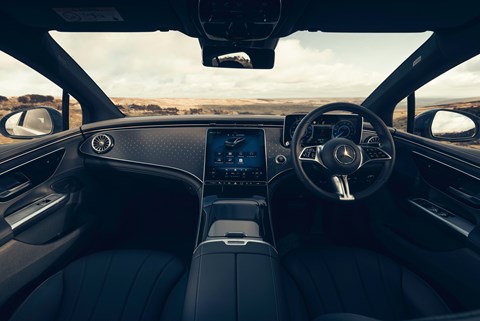
Stepping into the EQE, it certainly looks more like a modern luxury car. There’s no triple-display Hyperscreen package on this base car devoid of options, although I’d argue the portrait touchscreen with a separate instrument screen works better anyway. That’s partly because the few shortcut icons on the centre console are much easier to reach with the standard system; Hyperscreen-equipped cars have them more rearwards where they’re harder to see.
Even the standard set-up looks even more impressive than the ID.7’s, and it’s a little easier to navigate, too. If only the permanently displayed temperature controls weren’t at the bottom of the VW’s screen, requiring you to take your eyes off the road to find them. The driver’s display is also larger and clearer, although this car does without the ID.7’s excellent head-up display.
There are a number of areas where both the i5 and ID.7’s interiors comprehensively trump the EQE’s. Personally, I found it hard to get comfortable in the Mercedes. And for all its classy looks, the EQE’s interior is the most disappointing for quality. There’s no more hard plastic than you’ll find in the VW, but everything feels a bit flimsier than that or the i5. Plusher coverings are available for the seats and dash, and you can get full electric adjustment for the front seats on higher trims, but even these more expensive models aren’t finished as well as a Mercedes should be. Furthermore, the EQE has the smallest boot and is the tightest in the back, too.

The BMW driver’s set-up is far more conventional, and more effective. It doesn’t matter if you’re in a petrol-engined X1 or a fully electric i7 or the i5, you’ll still get two large, curved screens butted up against each other. The infotainment screen is mounted higher than in the Mercedes, and there’s the trusty iDrive controller between the front seats.
It’s also better screwed together inside and the ambient lighting is more art installation than lapdancing club, with a chunky, multi-faceted strip running the width of the cabin into the front doors. It’s much more appealing than the EQE’s neon striplights and the ID.7’s backlit piano black trims.
Although many buttons have been removed compared to the last-generation 5-series, there are still a few shortcut icons to help navigation, and mercifully there’s still that iDrive controller. The main screen is responsive and looks crisp, although having row upon row of icons in certain menus can be distracting when you’re driving.
Ah yes, driving. Let’s do some of that. There’s a reasonably broad spread of power here, with a predictable result at the traffic lights. With 330bhp, the i5 sprints from zero to 62mph in 6.0 seconds flat, half a second quicker than the 282bhp ID.7, with the 242bhp EQE nearly a second behind that. These cars don’t feel slow on the road, although those used to brisk acceleration might want to consider upgrading to the 288bhp EQE 350.
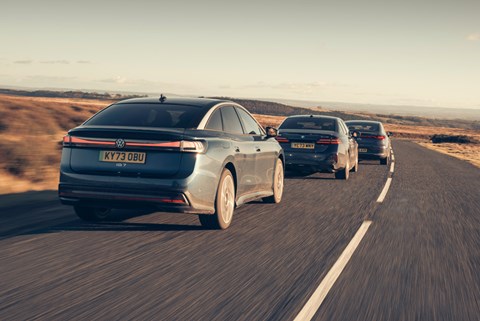
Electric cars generally go well; it’s the stopping that’s more of an issue. We’ve no problems with the effectiveness of the brakes on any of these cars – it’s pedal feel that’s our bone of contention. Both the ID.7 and EQE suffer from a long brake-pedal action with a clear change in effort as you push through the regenerative braking and start forcing pad against disc. The i5 feels far more natural in comparison.
There’s a mixture of suspension solutions: the EQE comes on steel springs and fixed dampers, the i5 gets steel up front and air on the back, and the ID.7 steel at both ends. Our ID.7 wears the optional adaptive dampers, but our EQE and i5 don’t have this box ticked, and nor do they have rear-wheel steer or active anti-roll bars.
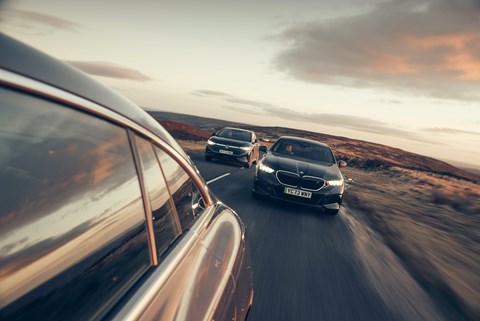
The ID.7’s dampers have a broad range of settings, helping it feel the most comfortable on the motorway. The ride is by no means perfect, with your head being gently tossed from side to side over bumps, and slightly loose body control in the softest damper settings. Go one notch firmer than Comfort on the Individual drive mode, and there’s appreciably better control with no great loss of comfort.
You’ll find the EQE is also happiest on the motorway. Like the ID.7 it’s quite softly sprung, although it transfers more of the shock from a sharp-edged hole or hump to the cabin. Combined with a slightly floaty feel over crests, compressions and undulations, it offers the least pleasant aspects of both soft suspension and hard.
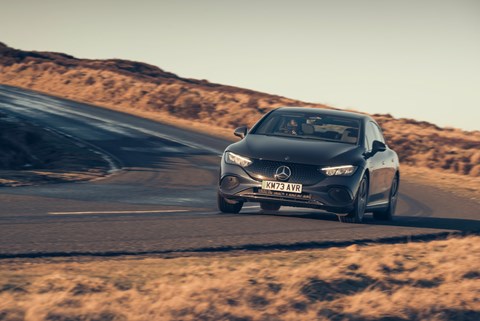
It’s the i5 that’s the firmest riding car here, but the payoff isn’t quite as great here as in other, lighter BMWs. It still treads that fine line between comfort and control most of the time but like all the cars here, you can feel the suspension working hard to manage the bulky kerbweight over larger undulations.
Would things have been different had the EQE and i5 been fitted with more sophisticated suspension? Absolutely, but it’s an expensive choice in the Merc, as you have to jump several trim levels. The i5’s system is definitely worth considering, especially for the additional manoeuvrability the bundled-in four-wheel steering brings.
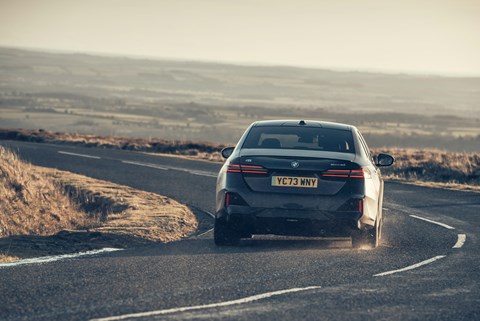
Weight makes the i5 fall short of being the ultimate driving machine. For a tall 2205kg electric saloon, it’s very capable and well balanced. However, the steering’s self-centring force is too strong, and it just feels heavy, like you’ve accidentally picked up the keys to a very quiet 7-series.
At least you can still disable the electronic stability control (once you’ve eventually found the right menu in the infotainment) and enjoy the pleasures of something with rear-wheel drive and more than 300bhp. Both the EQE and ID.7 have a halfway-house ESC mode that allows a little oversteer, but quickly restricts power if it thinks you’re getting greedy with the slip angle.

Of course, the ID.7 is far too serious to play silly buggers in the bends, but that doesn’t mean it handles badly. There’s a bit more lean than the i5, yet it’s also pleasingly neutral, grips well and has steering that feels more natural just off centre. Maybe it’s the weight difference, maybe it’s the ability to firm up the dampers, but the ID.7 is a little more agile, if not as overtly sporting.
Soft springs and lots of weight don’t do the EQE any favours in the bends, and the long brake pedal only increases that sense of mass. It has a good purchase on the road, and you can get down a B road briskly, but it feels like you’re battling physics rather than having fun.
Doing that does of course flatten the battery much more quickly than the official figures would have you believe. On our cold test day, efficiency tumbled below 3.0 miles per kWh as the cars were driven spiritedly across the Peaks, dropping range to around 200 miles.
A 150-mile journey mainly on motorways gave us the chance to test these cars’ efficiency in a type of trip that will be relevant to many owners of electric saloons. We stuck to the speed limit and avoided both hard acceleration and over-keen economy driving. Here, the EQE and i5 tie with efficiency of 3.1 miles per kWh, not particularly impressive from two cars designed with electric power in mind from day one.
The ID.7 fares slightly better with a figure of 3.4 miles per kWh. In all cases, a warmer day rather than a British winter would no doubt generate more impressive results. Based on these figures and the cars’ battery sizes, the EQE is capable of 275 miles, the i5 252, and the ID.7 261.
With those figures significantly down on the official stats, charging times and speeds suddenly become very important. If you’re talking rapid, the EQE can swallow up to 170kW, the i5 205 and the ID.7 175. In theory that gives them all a similar 10-80 per cent rapid charge time (31, 30 and 28 minutes respectively), although it was the BMW that always drew the most power.
With such large batteries, home charging takes a good while longer. For the EQE, empty to full takes just over 14 hours on a typical 7.4kW wallbox, around 13 for the i5 and 12 for the ID.7. All can benefit from 11kW AC charging, with 22kW AC optional on the i5. Worth knowing if your office has a bank of three-phase chargers.
Facts and figures: Volkswagen ID.7

The newest arrival of our trio, VW’s ID.7 is currently offered with the most limited choice, with prices starting at £51,550. For the moment it’s just the 282bhp rear-wheel-drive single-motor in either Pro Match or slightly fancier Launch Edition trim at £55,870. A twin-motor GTX is on the way, which will be perkier to some extent but don’t expect peak power to rival a BMW M model or an AMG-tuned Mercedes. The ID.7 is a five-door saloon/fastback-shaped hatchback, a bit like the Arteon, and an estate will follow.
Read our Volkswagen ID.7 review
Facts and figures: BMW i5
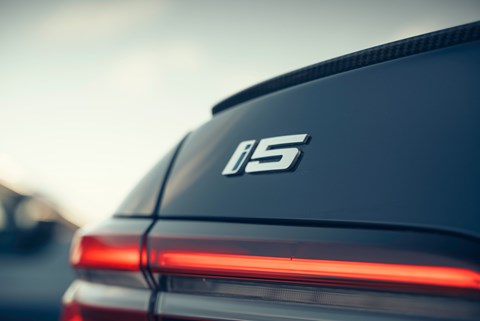
Currently, there’s a limited selection of i5s on offer, all towards the pricey end of what we expect to turn into a broader line-up in time. Currently the range kicks off at £74,105 with the 335bhp single-motor, rear-wheel-drive eDrive 40e, available in M Sport and more richly specified M Sport Pro trims, like our test car. The 593bhp twin-motor M60 tops the range, priced at £97,745; it’s greedier as well as quicker. The i5 is a four-door saloon, but an estate is on the way, mirroring the combustion-engine 5-series line-up.
Read our BMW i5 review
Facts and figures: Mercedes-Benz EQE
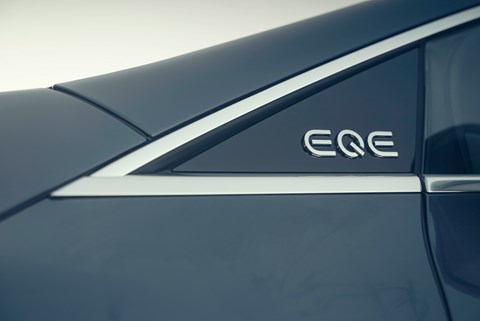
Unlike the i5, the entry point for the EQE line-up dips below £70k, if only just. That’ll get you a 242bhp rear-wheel-drive 300 Sport Edition, with three levels of AMG Line trim above it, and Exclusive Luxury sitting at the top of the regular range. Ours is the 300 Sport Edition. If you want more power, there’s a 288bhp single-motor 350 or the 616bhp twin-motor AMG 53 at £114,750. Whereas the combustion-engined E-Class is saloon and estate, the electric EQE is saloon-only, or there’s the taller SUV.
Read our Mercedes-Benz EQE review
ID.7 vs i5 vs EQE: the final reckoning

Electrification has levelled the playing field, with some manufacturers proving quicker to adapt and others struggling to express the brand’s DNA in its products. BMW has so far done better than most, arguably because its combustion cars and EVs are in so many cases so strongly related.
Meanwhile, VW and Mercedes have taken a different path, favouring a bespoke EV platform for ID, EQE and EQS models. In theory, this allows greater engineering freedom, although in practice there have been many well-documented problems.
However, while the smaller, lighter i4 eDrive 40 remains unmistakably a BMW to drive, and the much larger i7 a fine luxury car, the i5 finds itself in a bit of a no-man’s land. Without the clever chassis tech fitted to the i5 M60 we sampled previously, it’s too chunky to be truly fun to drive and a bit too firm to play the luxury cruiser.
It’s also not particularly efficient, and it’s by far the priciest on monthly finance (at least at the time of writing). Even so, there’s a lot to like. It has the best interior on test, with the highest quality here going a long way to suggest its expense is justified. It has the quickest acceleration and is also good to drive, assuming you’re not expecting it to handle like your old 5-series.
That’s easily enough to put it ahead of the temptingly priced Mercedes, keen finance deals making it around £300 cheaper than the i5. Given the longest range on test, with competitive charging rates and the in-your-face flash of the interior, it’ll be enough to make it many people’s choice.
The trouble with the Merc is that it feels a bit unfinished. From the flimsy trim to the unresolved suspension and odd driving position, it’s not as good a car as the i5. If only the BMW wasn’t so pricey.
That leaves the ID.7, the most complete-feeling ID yet. It shares a slightly unsettled ride with the rest of the family, but there’s not much else to criticise, thanks to the new infotainment system, backlit controls and interior quality. It’s also in some regards better to drive than the i5, as well as being the most efficient car on test and also the most spacious.
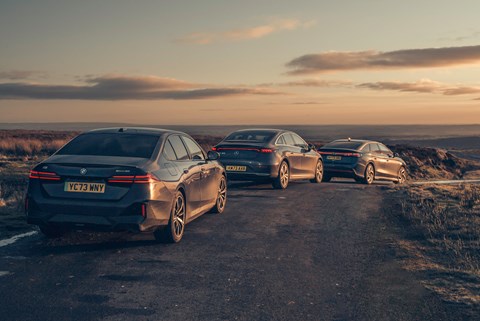
ID.7 vs i5 vs EQE: the verdict
First place
Volkswagen ID.7
ID starts to come good. Now give us some buttons
Second place
BMW i5
Good, but BMW is capable of better
Third place
Mercedes-Benz EQE
Needs to borrow the polish VW just found